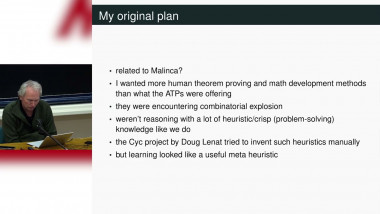
Some remarks about machine learning and (un)natural proving
By Josef Urban
Appears in collection : 2024 - T1 - WS1 - Quantum simulators
The Kardar–Parisi–Zhang (KPZ) equation [1], originally derived to describe the kinetic roughening of growing interfaces is a stochastic non-linear differential equation that applies to a large class of non-equilibrium systems, ranging from the growth of nematic liquid crystal clusters, of bacterial colonies, or the propagation of a combustion front. The shape of such an interface h(r,t) is described by the following stochastic equation: ∂_t h=v∇^2 h+λ/2 (∇h)^2+η, where the first term is a smoothening diffusion, the second term is a crucial nonlinear contribution that leads to critical roughening of the interface and η is a Gaussian noise. Interestingly the spatial and temporal correlation functions of h(r,t) show universal scaling laws, with critical exponents that only depend on the dimensionality whatever the system .
Recently, it was discovered that the phase dynamics in the coherent emission of out of equilibrium condensates of light (named polariton condensates) also obeys the celebrated KPZ equation [2-4]. Interestingly, since the phase is a compact variable, periodically defined between 0 and 2 the physics is enriched by the possible emergence of vortices. Actually even in 1D, where usually vortices are excluded, exotic spatio-temporel vortices have been predicted to play a role [5].
In the present talk, after a general introduction to the cavity polaritons, I will explain how we could generate extended 1D polariton condensates [6] and probe their first order coherence. We demonstrate that the spatio-temporal decay of the first order coherence presents universal scaling laws characteristic for the KPZ universality class in 1D [7]. The influence of vortices in these experiments will be discussed as well as the extension of this work in 2D [2].
Our work highlight the profound difference between driven-dissipative out of equilibrium condensates and their equilibrium counterparts. We anticipate that this physics should also be relevant in extended vertical cavity lasers.
M. Kardar, G. Parisi, and Y. C. Zhang, Dynamic Scaling of Growing Interfaces, Phys. Rev. Lett. 56, 889 (1986)
E. Altman, et al., Two-Dimensional Superfluidity of Exciton Polaritons Requires Strong Anisotropy, Phys. Rev. X 5, 011017 (2015).
K. Ji, et al., Temporal coherence of one-dimensional nonequilibrium quantum fluids, Phys. Rev. B 91, 045301 (2015).
L. He, et al., Scaling properties of one-dimensional driven-dissipative condensates, Phys. Rev. B 92, 155307 (2015)
L. He et al, Space-time vortex driven crossover and vortex turbulence phase transition in one-dimensional driven open condensates. Physical review letters 118, 085301 (2017).
F. Baboux, et al., Unstable and stable regimes of polariton condensation, Optica 5, 1163 (2018)
Q. Fontaine et al, Kardar-Parisi-Zhang universality in a one-dimensional polariton condensate, Nature 608, 687 (2022)
K. Deligiannis et al., Kardar-Parisi-Zhang universality in discrete two-dimensional driven-dissipative exciton polariton condensates, Phys. Rev. Research 4, 043207 (2022)
